
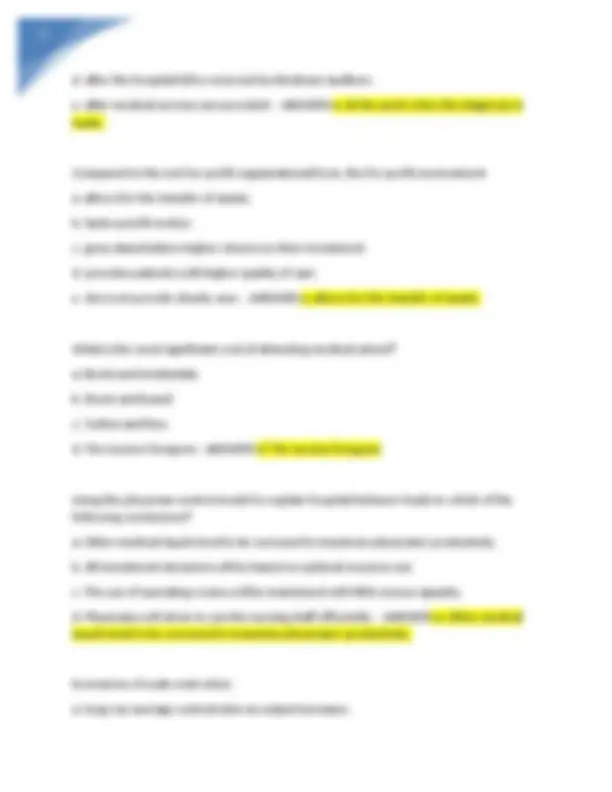
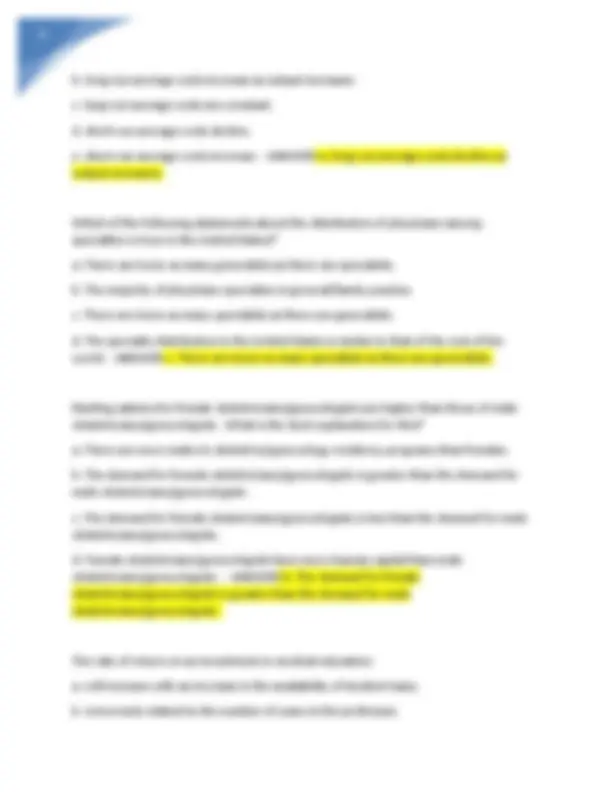
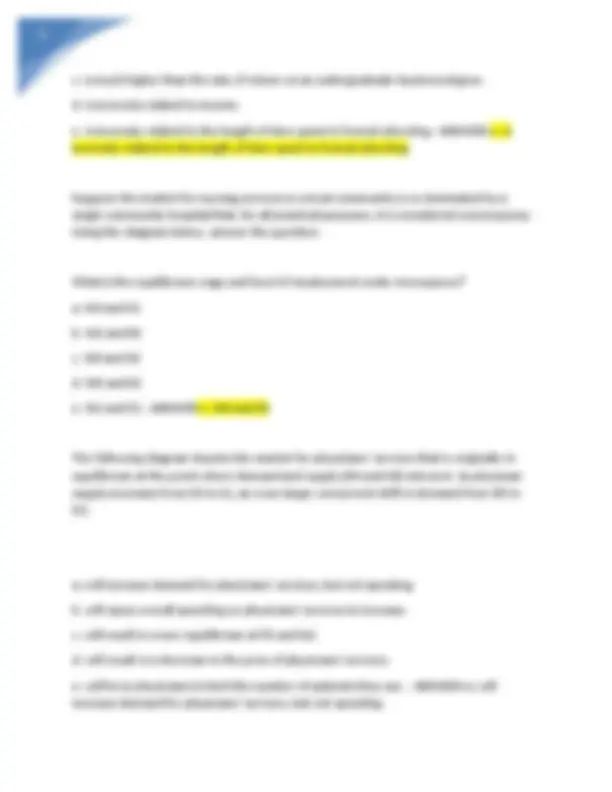
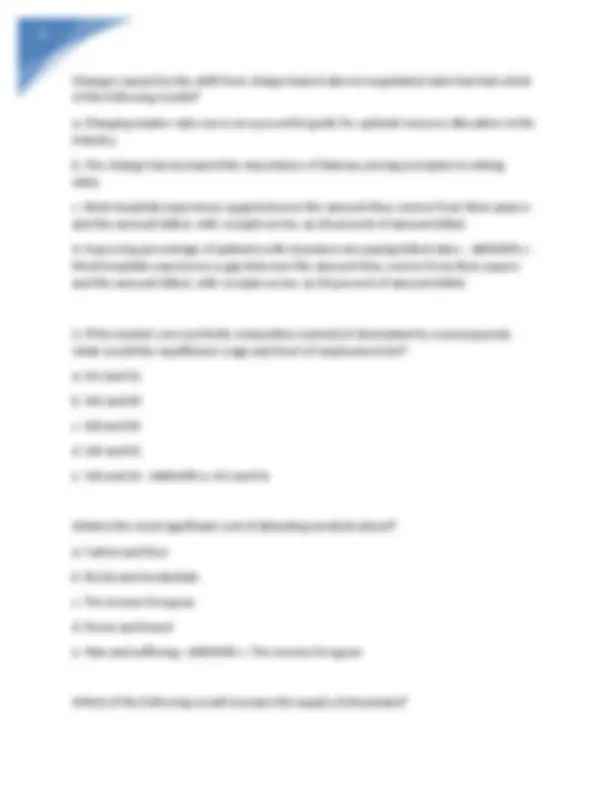
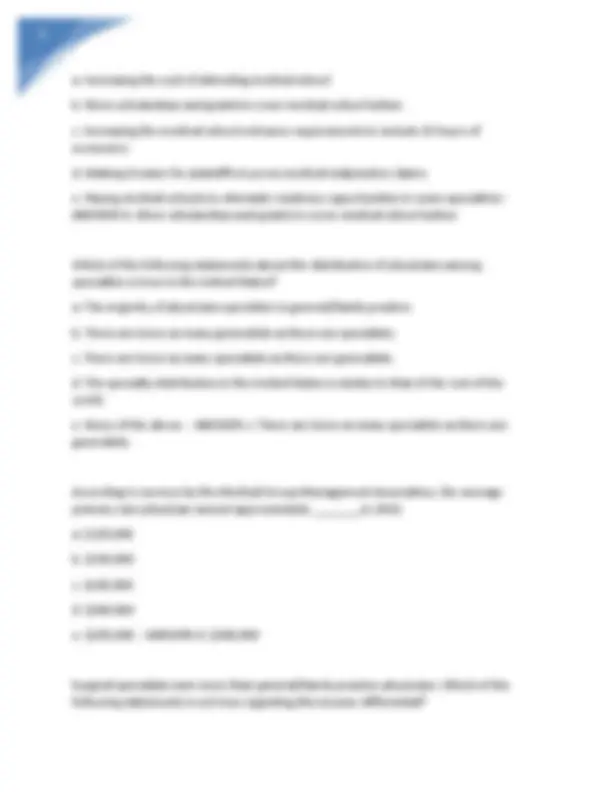
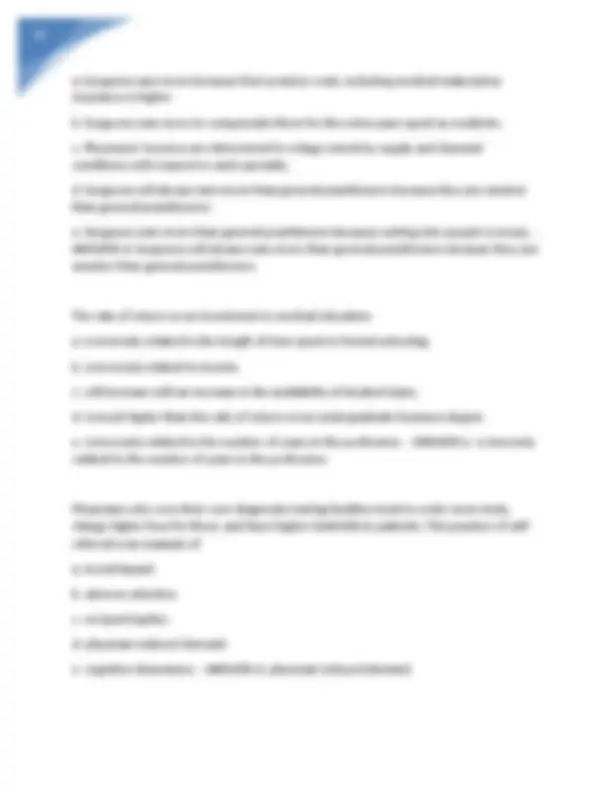
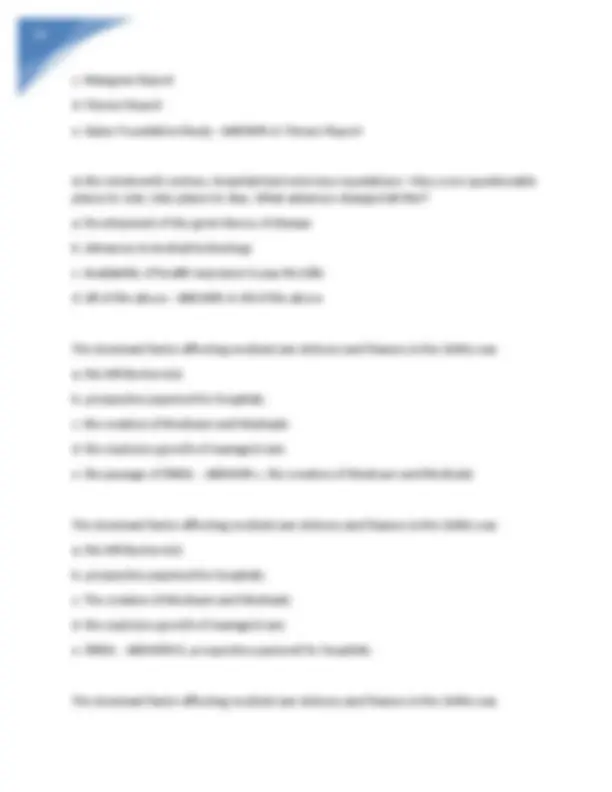
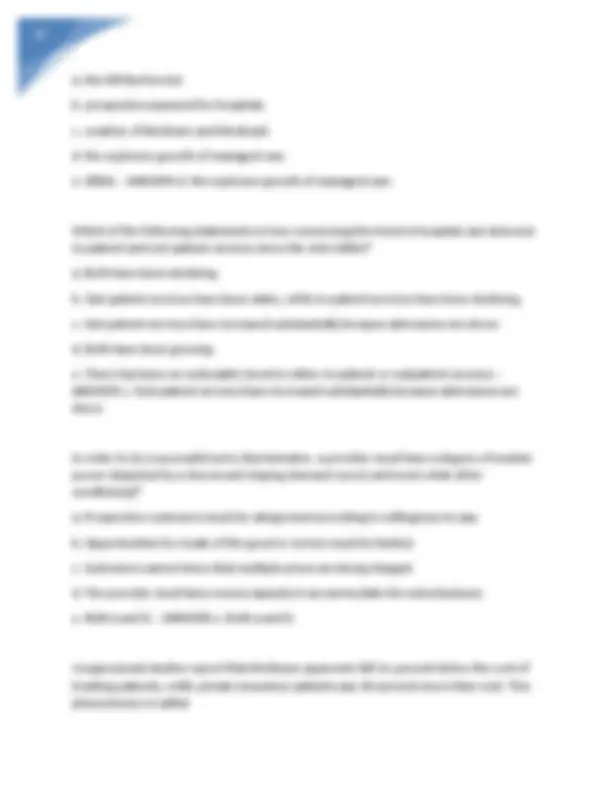
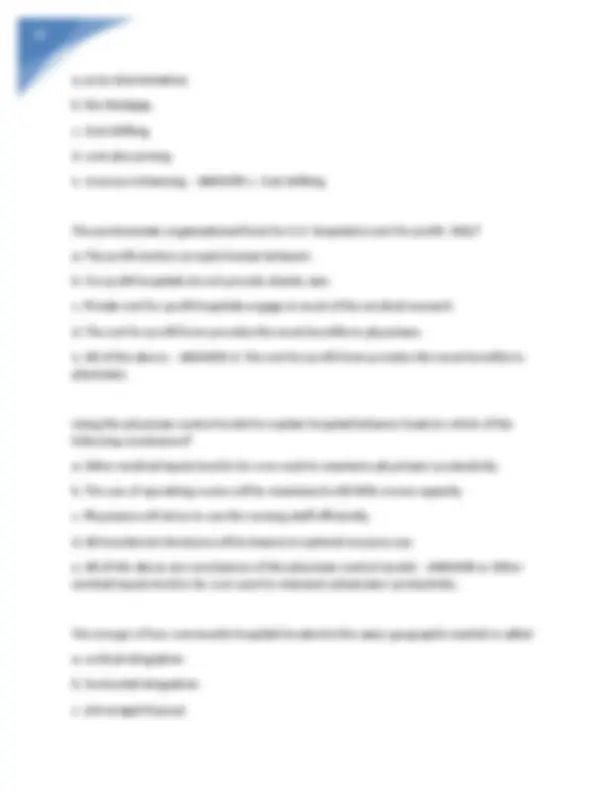
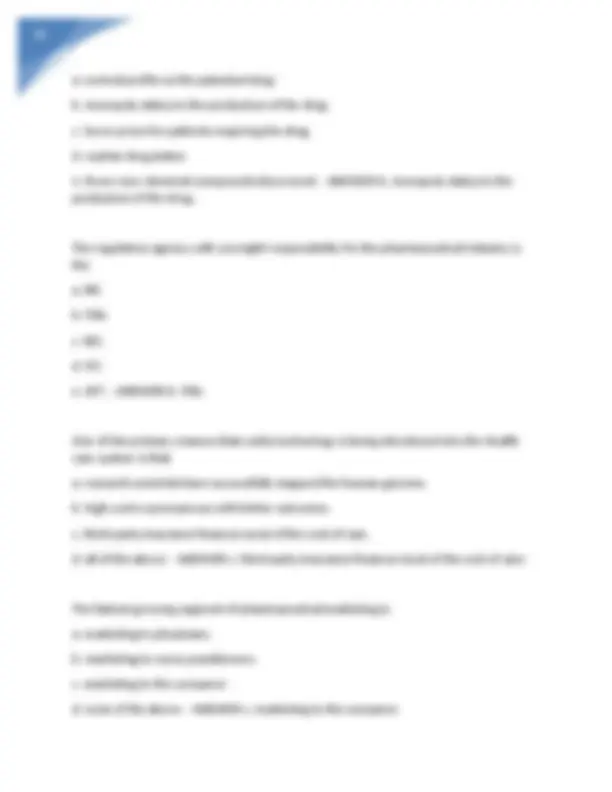
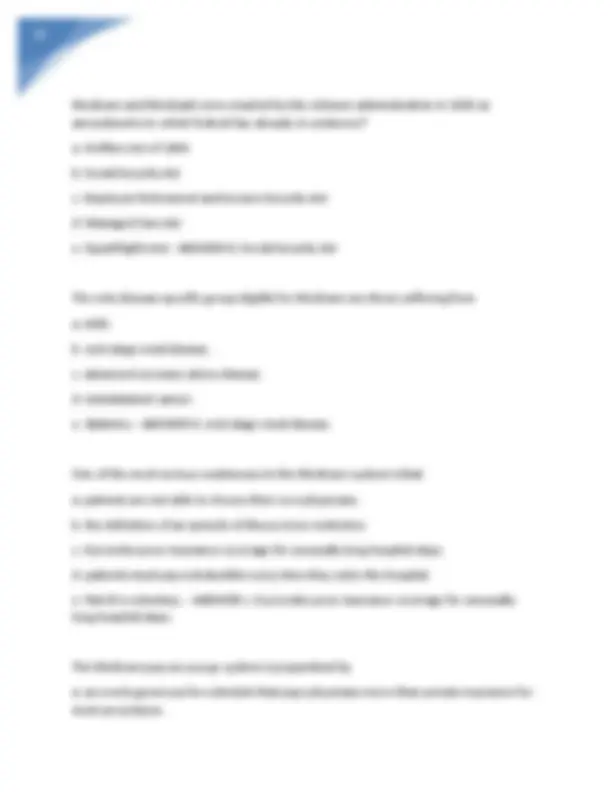
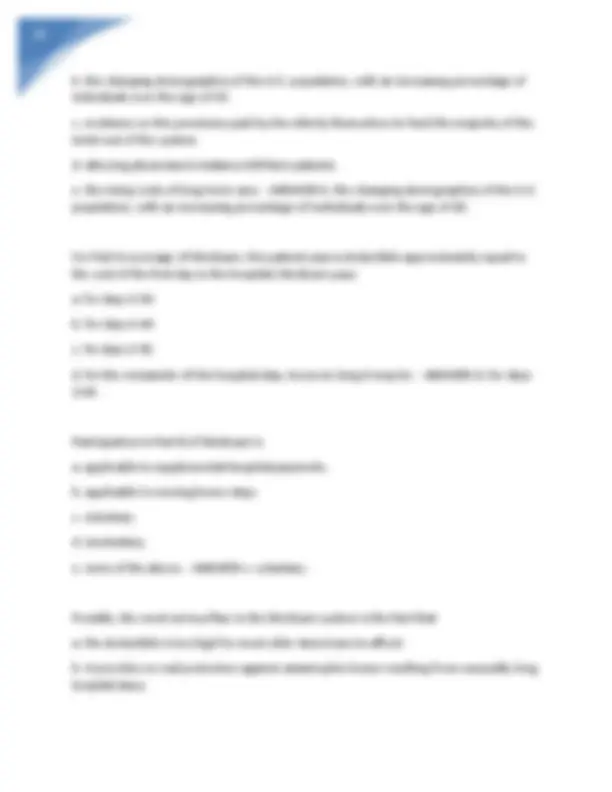
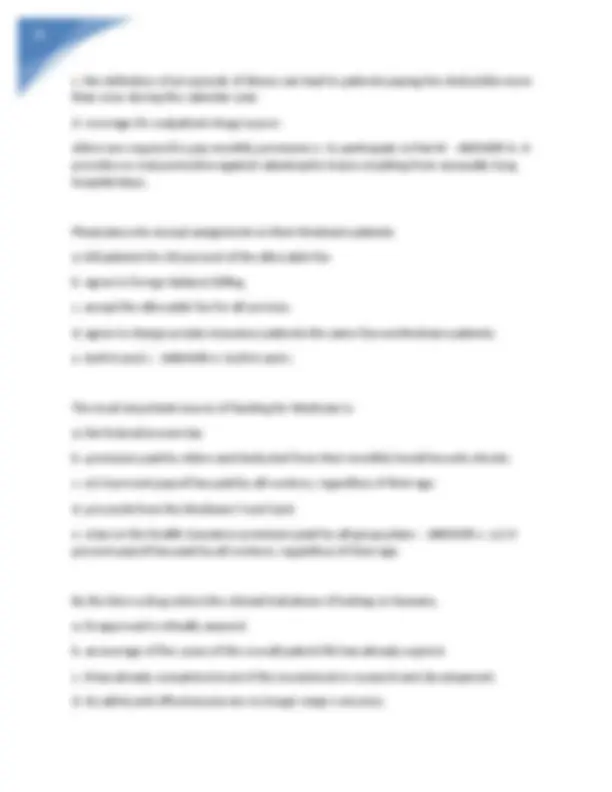
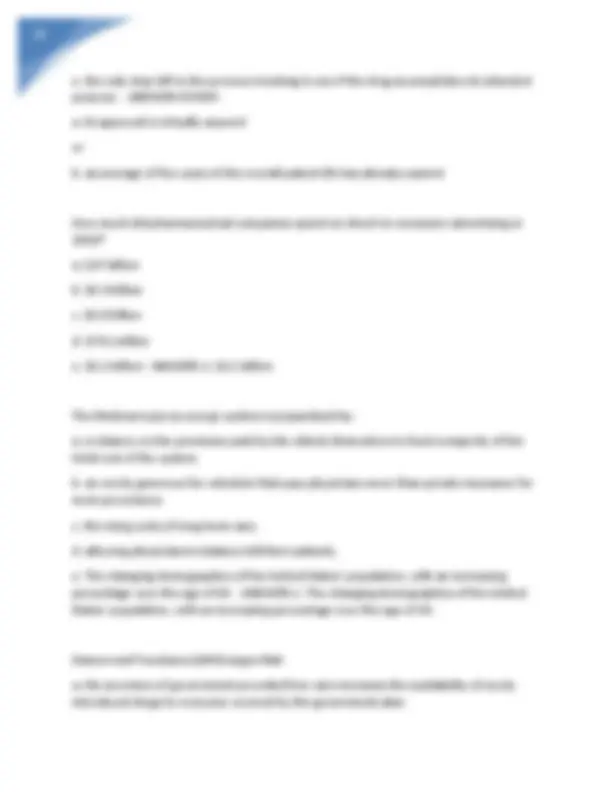
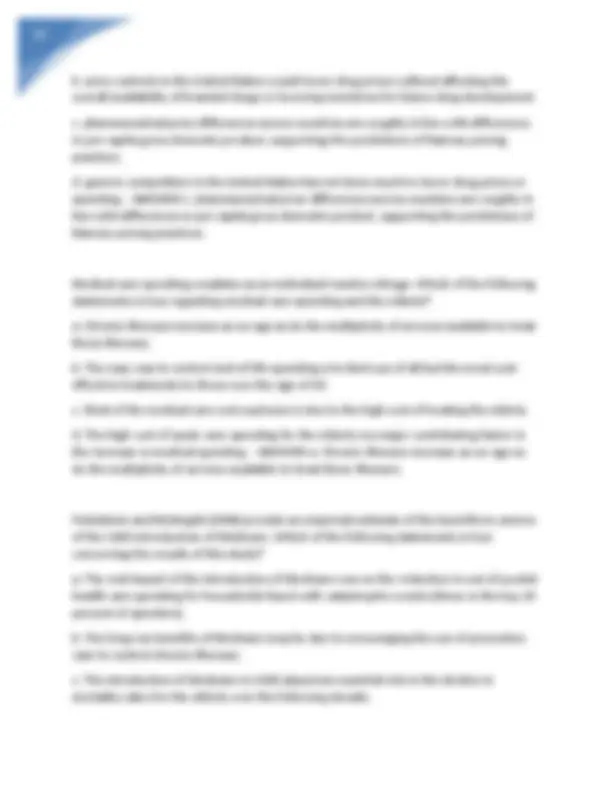
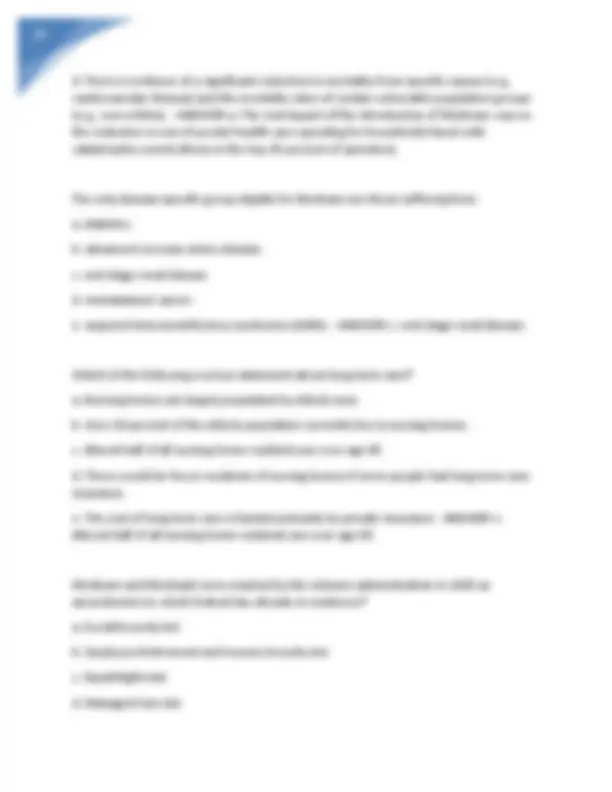
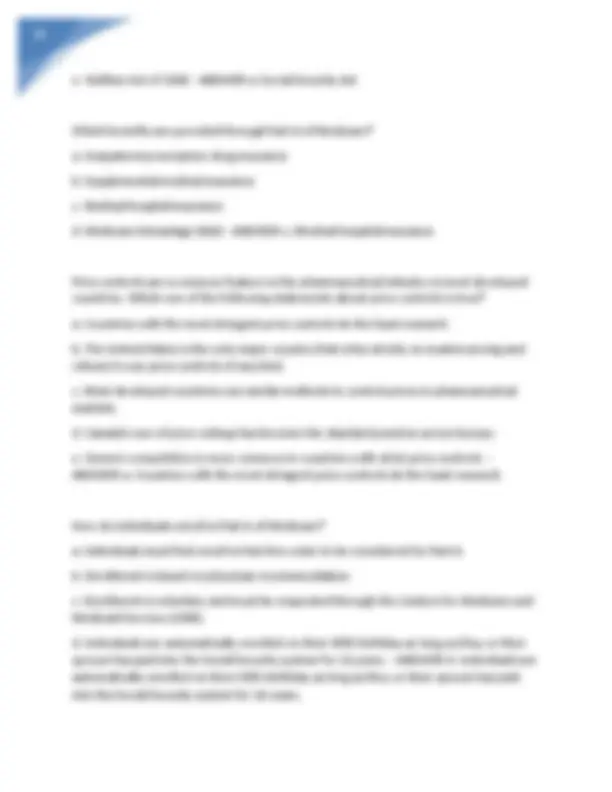
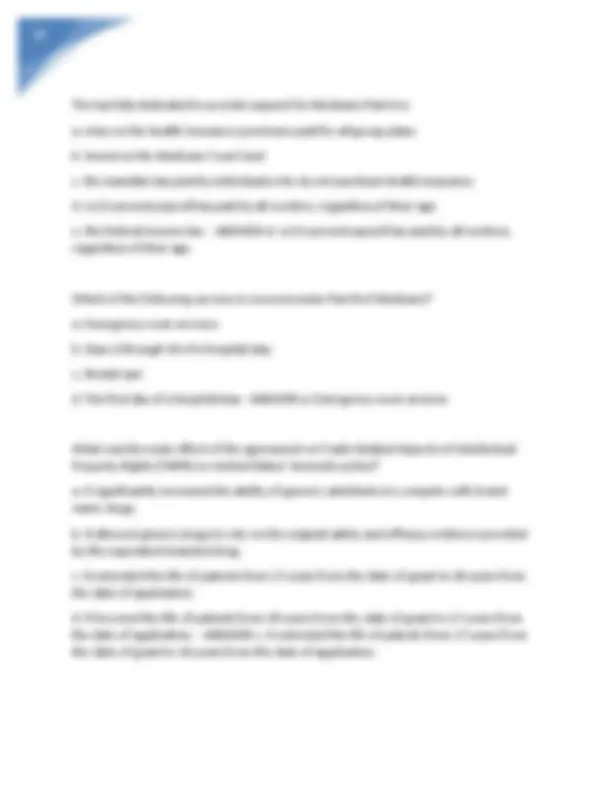
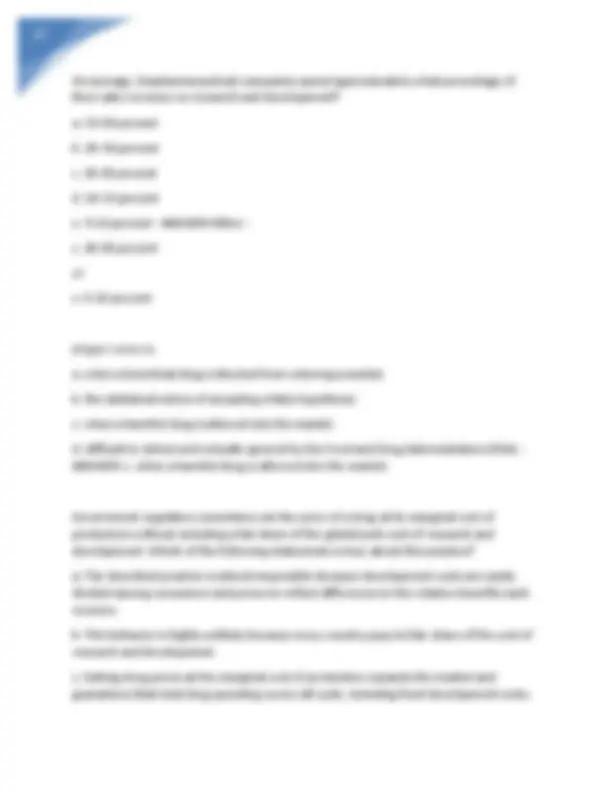
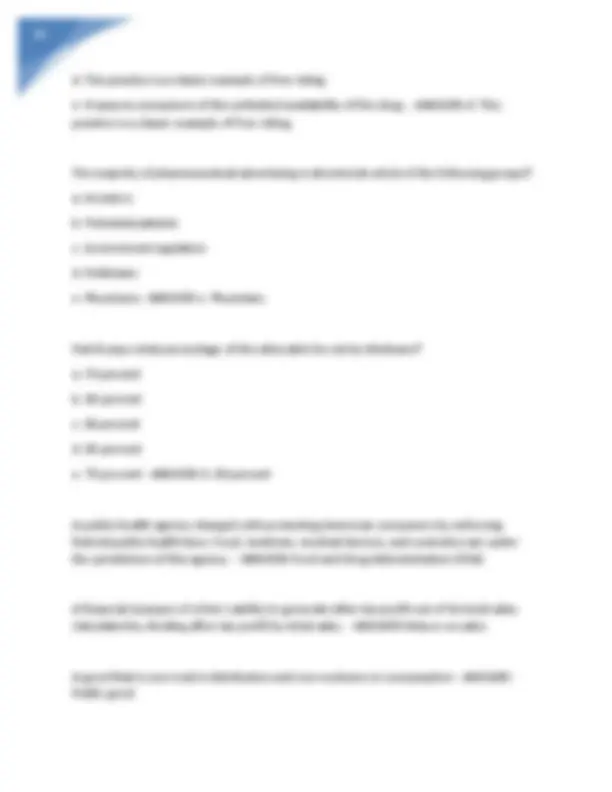
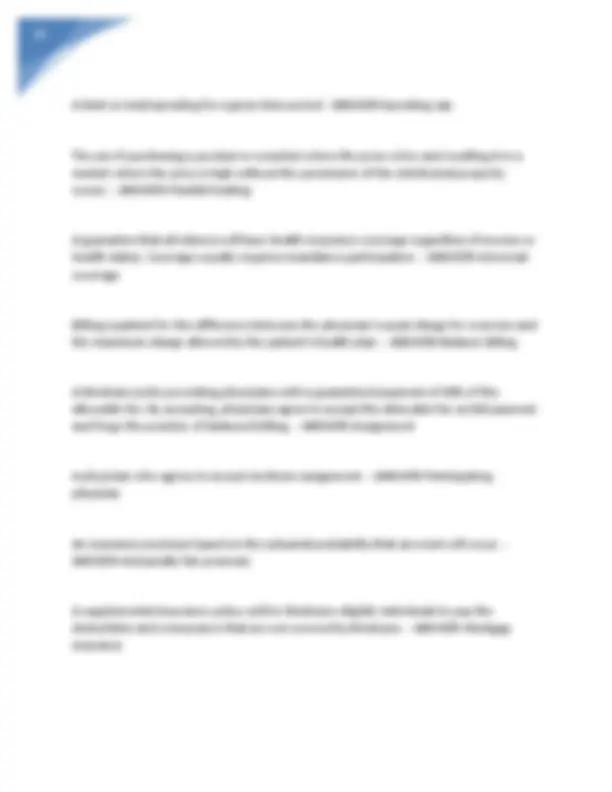
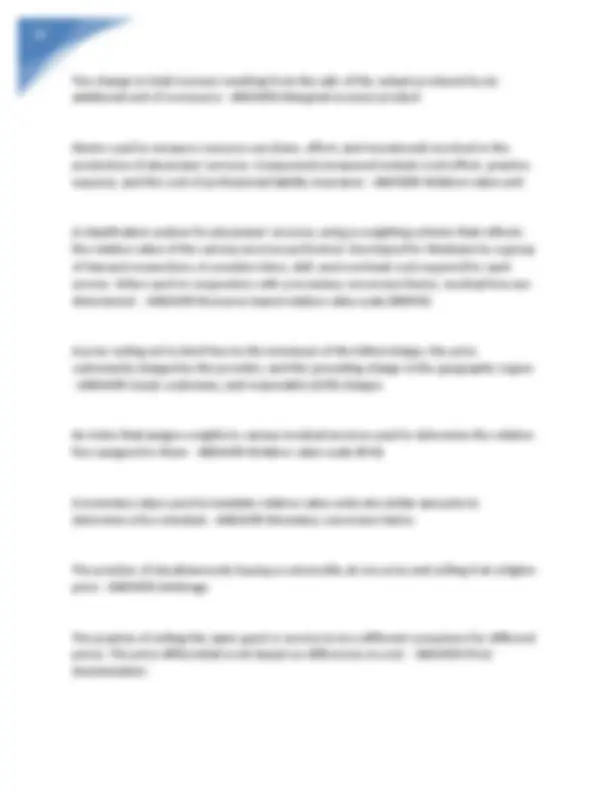
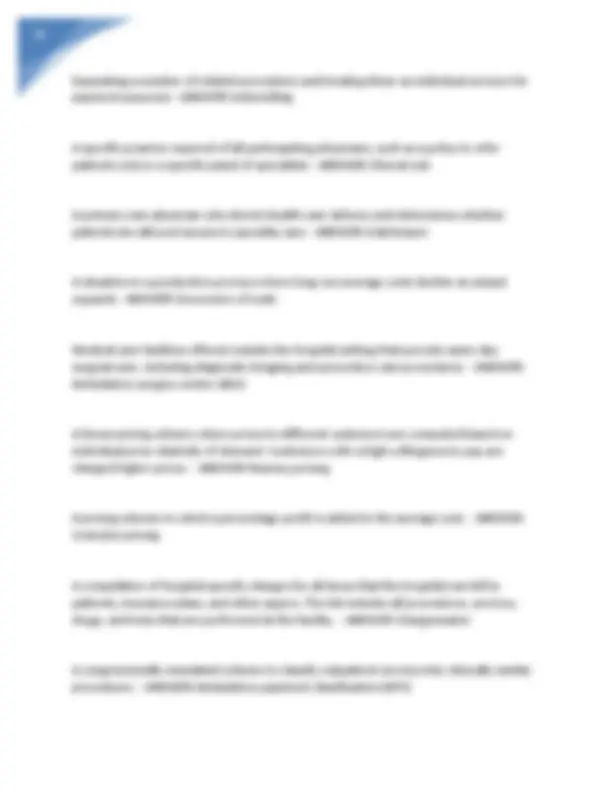


Study with the several resources on Docsity

Earn points by helping other students or get them with a premium plan


Prepare for your exams
Study with the several resources on Docsity

Earn points to download
Earn points by helping other students or get them with a premium plan
Community
Ask the community for help and clear up your study doubts
Discover the best universities in your country according to Docsity users
Free resources
Download our free guides on studying techniques, anxiety management strategies, and thesis advice from Docsity tutors
MHA 710 HEALTHCARE ECONOMICS EXAM |LATEST 2024 EXAM WITH ACCURATE QUESTIONS AND CORRECT VERIFIED ANSWERS |PRE-EVALUATED A+/MHA 710 HEALTHCARE ECONOMICS EXAM |LATEST 2024 EXAM WITH ACCURATE QUESTIONS AND CORRECT VERIFIED ANSWERS |PRE-EVALUATED A+/MHA 710 HEALTHCARE ECONOMICS EXAM |LATEST 2024 EXAM WITH ACCURATE QUESTIONS AND CORRECT VERIFIED ANSWERS |PRE-EVALUATED A+
Typology: Exams
1 / 31

This page cannot be seen from the preview
Don't miss anything!
























In order to be a successful price discriminator, a provider must have a degree of market power (depicted by a downward-sloping demand curve) and meet what other condition(s)?
a. Customers cannot know that different prices are being charged.
b. Markets must be segmentable, identifying differences in ability to pay.
c. Demand for services must be relatively price elastic.
d. Profitable service expansion opportunities must be limited.
e. The provider must have excess capacity to accommodate the extra business. - ANSWER-b. Markets must be segmentable, identifying differences in ability to pay.
Legislation considered by Congress to restrict legal immigration would:
a. surprise many policymakers because Congress finds it difficult to agree on much of anything regarding immigration.
b. improve employment prospects for native-born Americans.
c. have little effect on medical markets, as so few physicians practicing medicine in the United States are foreigners.
d. raise the costs of operating in many of the nation's rural and inner-city hospitals.
e. allow more Americans trained abroad to compete for openings in United States' residency programs. - ANSWER-d. raise the costs of operating in many of the nation's rural and inner-city hospitals.
Physicians who own their own diagnostic testing facilities tend to order more tests, charge higher fees for them, and have higher total bills to patients. This practice of self- referral is an example of:
a. cognitive dissonance.
b. physician-induced demand.
c. moral hazard.
d. adverse selection.
e. res ipsa loquitur. - ANSWER-b. physician-induced demand.
Which of the following statements is true concerning the trend in community hospital care between inpatient and outpatient services since the mid-1980s?
a. Both inpatient and outpatient services have been declining.
b. There has been no noticeable trend in either inpatient or outpatient services.
c. Both inpatient and outpatient services have been growing.
d. Outpatient services have been growing, while inpatient services have been declining.
e. Outpatient services have been declining, while inpatient services have been growing.
The amount that Medicare pays a hospital for treating a Medicare patient is determined:
a. at the point when the diagnosis is made.
b. at the time of admission to the hospital.
c. before the patient sees a physician.
b. long-run average costs increase as output increases.
c. long-run average costs are constant.
d. short-run average costs decline.
e. short-run average costs increase. - ANSWER-a. long-run average costs decline as output increases.
Which of the following statements about the distribution of physicians among specialties is true in the United States?
a. There are twice as many generalists as there are specialists.
b. The majority of physicians specialize in general/family practice.
c. There are twice as many specialists as there are generalists.
d. The specialty distribution in the United States is similar to that of the rest of the world. - ANSWER-c. There are twice as many specialists as there are generalists.
Starting salaries for female obstetricians/gynecologists are higher than those of male obstetricians/gynecologists. What is the best explanation for this?
a. There are more males in obstetrics/gynecology residency programs than females.
b. The demand for female obstetricians/gynecologists is greater than the demand for male obstetricians/gynecologists.
c. The demand for female obstetricians/gynecologists is less than the demand for male obstetricians/gynecologists.
d. Female obstetricians/gynecologists have more human capital than male obstetricians/gynecologists. - ANSWER-b. The demand for female obstetricians/gynecologists is greater than the demand for male obstetricians/gynecologists.
The rate of return on an investment in medical education:
a. will increase with an increase in the availability of student loans.
b. is inversely related to the number of years in the profession.
c. is much higher than the rate of return on an undergraduate business degree.
d. is inversely related to income.
e. is inversely related to the length of time spent in formal schooling - ANSWER-e. is inversely related to the length of time spent in formal schooling
Suppose the market for nursing services in a local community is so dominated by a single community hospital that, for all practical purposes, it is considered a monopsony. Using the diagram below, answer the question.
What is the equilibrium wage and level of employment under monopsony?
a. W0 and E
b. W2 and E
c. W0 and E
d. W0 and E
e. W1 and E1 - ANSWER-c. W0 and E
The following diagram depicts the market for physicians' services that is originally in equilibrium at the point where demand and supply (D0 and S0) intersect. As physician supply increases from S0 to S1, an even larger concurrent shift in demand from D0 to D1:
a. will increase demand for physicians' services, but not spending.
b. will cause overall spending on physicians' services to increase.
c. will result in a new equilibrium at P2 and Q2.
d. will result in a decrease in the price of physicians' services.
e. will force physicians to limit the number of patients they see. - ANSWER-a. will increase demand for physicians' services, but not spending.
If the market were perfectly competitive instead of dominated by a monopsonist, what would the equilibrium wage and level of employment be?
a. W2 and E
b. W0 and E
c. W0 and E
d. W0 and E
e. W1 and E1 - ANSWER-e. W1 and E
Which of the following statements is true about cost shifting in hospitals?
a. Regardless of payer mix, hospitals are taking full advantage of their bargaining power with payers who are able to cost shift.
b. Capacity-constrained medical providers are not able to cost shift.
c. The positive correlation coefficient between cost-to-payment ratios for various payers indicates that cost shifting is taking place.
d. The ability to cost shift depends on a hospital's payer mix.
e. Classic Ramsey pricing can be interpreted in different ways, leading researchers into arguing that if it looks like cost shifting, it probably is cost shifting. - ANSWER-d. The ability to cost shift depends on a hospital's payer mix.
This study was the catalyst for the early twentieth century reform of medical education in the United States. What was it?
a. Hill-Burton Committee
b. Mangrum Report
c. Coolidge Commission
d. Flexner Report
e. Kaiser Foundation Study - ANSWER-d. Flexner Report
Changes caused by the shift from charge-based rates to negotiated rates has had which of the following results?
a. Charging master rates serve as a powerful guide for optimal resource allocation in the industry.
b. The change has increased the importance of Ramsey pricing principles in setting rates.
c. Most hospitals experience a gap between the amount they receive from their payers and the amount billed, with receipts as low as 20 percent of amount billed.
d. A growing percentage of patients with insurance are paying billed rates. - ANSWER-c. Most hospitals experience a gap between the amount they receive from their payers and the amount billed, with receipts as low as 20 percent of amount billed.
a. W1 and E
b. W2 and E
c. W0 and E
d. W0 and E
e. W0 and E2 - ANSWER-a. W1 and E
What is the most significant cost of attending medical school?
a. Tuition and fees
b. Books and incidentals
c. The income foregone
d. Room and board
e. Pain and suffering - ANSWER-c. The income foregone
Which of the following would increase the supply of physicians?
a. Surgeons earn more because their practice costs, including medical malpractice insurance is higher.
b. Surgeons earn more to compensate them for the extra years spent as residents.
c. Physicians' incomes are determined to a large extent by supply and demand conditions with respect to each specialty.
d. Surgeons will always earn more than general practitioners because they are smarter than general practitioners.
e. Surgeons earn more than general practitioners because cutting into people is messy. - ANSWER-d. Surgeons will always earn more than general practitioners because they are smarter than general practitioners.
The rate of return on an investment in medical education
a. is inversely related to the length of time spent in formal schooling.
b. is inversely related to income.
c. will increase with an increase in the availability of student loans.
d. is much higher than the rate of return on an undergraduate business degree.
e. is inversely related to the number of years in the profession. - ANSWER-e. is inversely related to the number of years in the profession.
Physicians who own their own diagnostic testing facilities tend to order more tests, charge higher fees for them, and have higher total bills to patients. This practice of self- referral is an example of
a. moral hazard.
b. adverse selection.
c. res ipsa loquitur.
d. physician-induced demand.
e. cognitive dissonance. - ANSWER-d. physician-induced demand.
The observed variations in practice patterns in different regions of the country are difficult to eliminate
a. because of the many alternative treatment options available for most ailments.
b. due to the localized nature of most medical practice.
c. because it is difficult to change the preferences of physicians and patients.
d. the observed variations are so minor that they are of little concern to policy makers.
e. a, b, and c are true. - ANSWER-e. a, b, and c are true.
To address the shortage of physicians on the horizon, it will be necessary to
a. build more medical schools.
b. provide more grants and scholarships for medical education.
c. allow the admission of more foreign-educated physicians.
d. all of the above. - ANSWER-d. all of the above.
In 2010, the medical specialty that earned the highest rate of return on investment was
a. general primary care.
b. Internal medicine.
c. Pediatrics.
d. orthopedic surgery.
e. none of the above. - ANSWER-d. orthopedic surgery.
Suppose the number of medical school graduates continues to increase over the next decade. Which of the following is true?
a. Physicians' salaries must fall.
b. Physicians' salaries must rise.
c. Physicians' salaries will fall only if the demand for medical services falls.
c. Mangrum Report
d. Flexner Report
e. Kaiser Foundation Study - ANSWER-d. Flexner Report
In the nineteenth century, hospitals had notorious reputations—they were questionable places to visit, risky places to stay. What advances changed all this?
a. Development of the germ theory of disease
b. Advances in medical technology
c. Availability of health insurance to pay the bills
d. All of the above - ANSWER-d. All of the above
The dominant factor affecting medical care delivery and finance in the 1960s was
a. the Hill-Burton Act.
b. prospective payment for hospitals.
c. the creation of Medicare and Medicaid.
d. the explosive growth of managed care.
e. the passage of ERISA. - ANSWER-c. the creation of Medicare and Medicaid.
The dominant factor affecting medical care delivery and finance in the 1980s was
a. the Hill-Burton Act.
b. prospective payment for hospitals.
c. The creation of Medicare and Medicaid.
d. the explosive growth of managed care.
e. ERISA. - ANSWER-b. prospective payment for hospitals.
The dominant factor affecting medical care delivery and finance in the 1990s was
a. the Hill-Burton Act.
b. prospective payment for hospitals.
c. creation of Medicare and Medicaid.
d. the explosive growth of managed care.
e. ERISA. - ANSWER-d. the explosive growth of managed care.
Which of the following statements is true concerning the trend in hospital care between in-patient and out-patient services since the mid-1980s?
a. Both have been declining.
b. Out-patient services have been static, while in-patient services have been declining.
c. Out-patient services have increased substantially because admissions are down.
d. Both have been growing.
e. There has been no noticeable trend in either in-patient or outpatient services. - ANSWER-c. Out-patient services have increased substantially because admissions are down.
In order to be a successful price discriminator, a provider must have a degree of market power (depicted by a downward-sloping demand curve) and meet what other condition(s)?
a. Prospective customers must be categorized according to willingness-to-pay.
b. Opportunities for resale of the good or service must be limited.
c. Customers cannot know that multiple prices are being charged.
d. The provider must have excess capacity to accommodate the extra business.
e. Both a and b. - ANSWER-e. Both a and b.
Congressional studies report that Medicare payments fall 11 percent below the cost of treating patients, while private insurance patients pay 29 percent more than cost. This phenomenon is called
d. a conglomerate merger.
e. a real shame, since one of the hospitals will likely close. - ANSWER-b. horizontal integration.
Economies of scale exist when
a. long-run average costs decline as output increases.
b. long-run average costs are constant.
c. long-run average costs increase as output increases.
d. short-run average costs decline.
e. short-run average costs increase. - ANSWER-a. long-run average costs decline as output increases.
Horizontal integration allows firms to do all of the following except
a. take advantage of cost savings due to economies of scale.
b. reduce administrative costs.
c. create brand identity.
d. fully integrate with primary care clinics and acute care nursing facilities. - ANSWER-d. fully integrate with primary care clinics and acute care nursing facilities.
Consolidation activity in the hospital industry
a. has slowed due to government regulations.
b. has created a large number of nationwide for-profit hospital chains.
c. has occurred almost exclusively at the local level.
d. occurs for same reasons that cause consolidation in other industries. - ANSWER-d. occurs for same reasons that cause consolidation in other industries.
What is the most important factor leading to rising health care costs in the United States since 1980?
a. The increased use of expensive medical technology
b. The aging U.S. population
c. The increased cost of malpractice insurance for providers
d. Rising incomes for physicians
e. The rising cost of pharmaceutical drugs - ANSWER-a. The increased use of expensive medical technology
Rent-seeking behavior results in
a. increased economic activity by promoting efficiency.
b. lower economic activity by diverting resource to less-productive uses.
c. a more equitable distribution of income and wealth.
d. lower prices throughout the economy.
e. greater income and wealth in the private sector. - ANSWER-b. lower economic activity by diverting resource to less-productive uses.
Of the new drugs introduced in the United States between 1940 and 1990, what percentage were discovered by U.S. firms?
a. 15 percent
b. 30 percent
c. 45 percent
d. 60 percent
e. 75 percent - ANSWER-d. 60 percent
Pharmaceutical companies receive patents as an exclusive right to produce a drug. This results in
Medicare and Medicaid were enacted by the Johnson administration in 1965 as amendments to which federal law already in existence?
a. Welfare Act of 1960
b. Social Security Act
c. Employee Retirement and Income Security Act
d. Managed Care Act
e. Equal Rights Act - ANSWER-b. Social Security Act
The only disease-specific group eligible for Medicare are those suffering from
a. AIDS.
b. end-stage renal disease.
c. advanced coronary artery disease.
d. metastasized cancer.
e. diabetes. - ANSWER-b. end-stage renal disease.
One of the most serious weaknesses in the Medicare system is that
a. patients are not able to choose their own physicians.
b. the definition of an episode of illness is too restrictive.
c. it provides poor insurance coverage for unusually long hospital stays.
d. patients must pay a deductible every time they enter the hospital.
e. Part B is voluntary. - ANSWER-c. it provides poor insurance coverage for unusually long hospital stays.
The Medicare pay-as-you-go system is jeopardized by
a. an overly generous fee schedule that pays physicians more than private insurance for most procedures.
b. the changing demographics of the U.S. population, with an increasing percentage of individuals over the age of 65.
c. a reliance on the premiums paid by the elderly themselves to fund the majority of the total cost of the system.
d. allowing physicians to balance bill their patients.
e. the rising costs of long-term care. - ANSWER-b. the changing demographics of the U.S. population, with an increasing percentage of individuals over the age of 65.
For Part A coverage of Medicare, the patient pays a deductible approximately equal to the cost of the first day in the hospital; Medicare pays
a. for days 2-30.
b. for days 2-60.
c. for days 2-90.
d. for the remainder of the hospital stay, however long it may be. - ANSWER-b. for days 2-60.
Participation in Part B of Medicare is
a. applicable to supplemental hospital payments.
b. applicable to nursing home stays
c. voluntary.
d. involuntary.
e. none of the above. - ANSWER-c. voluntary.
Possibly, the most serious flaw in the Medicare system is the fact that
a. the deductible is too high for most older Americans to afford.
b. it provides no real protection against catastrophic losses resulting from unusually long hospital stays.